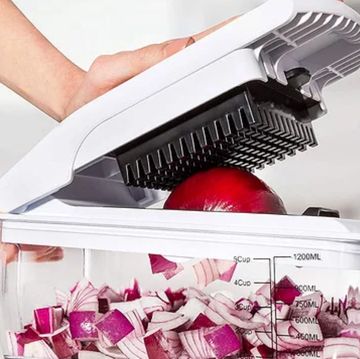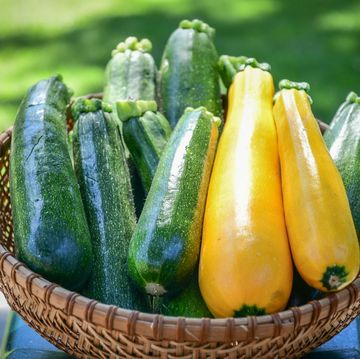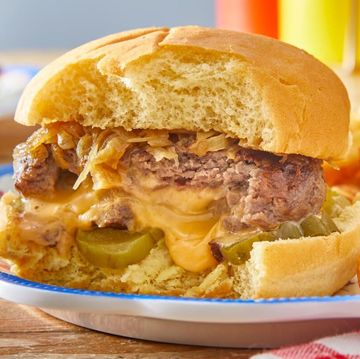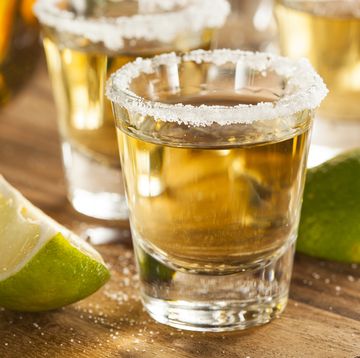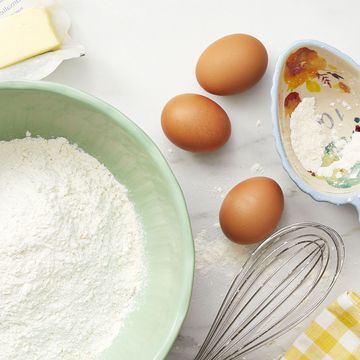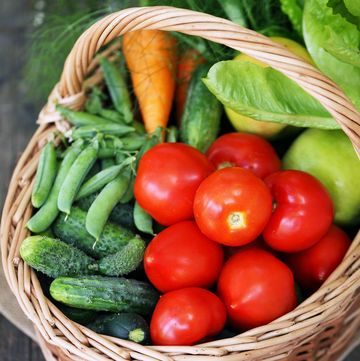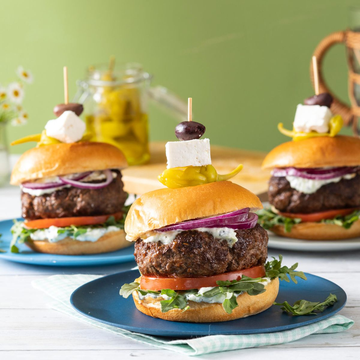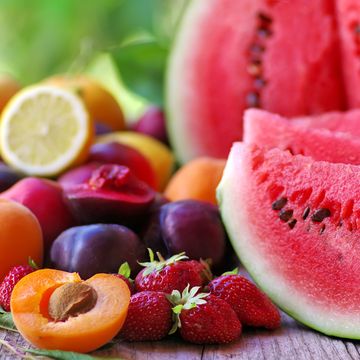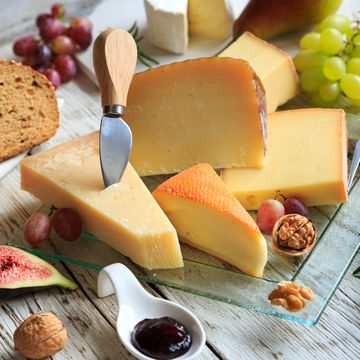1All-Purpose Flour
 Glasshouse Images//Getty Images
Glasshouse Images//Getty ImagesThis is the most versatile of them all. Made from hard or soft wheat or a combination of both, the protein content of all-purpose flour hovers around nine to 12 percent, which is neither high nor low. Unbleached flour has whitened naturally with age; bleached flour is treated to lighten it faster. Unbleached flour may also yield a denser texture than bleached, but even with trace differences, the flours are interchangeable.
Use it for: everyday baking and cooking—the possibilities are endless!
2Whole Wheat Flour
 Lucas Ninno//Getty Images
Lucas Ninno//Getty ImagesTime to get a little scientific: Wheat kernels are broken down into three parts before being milled—the endosperm, germ and bran. Standard white flour is made up of milled endosperm, but whole wheat flour is comprised of all three parts. This makes for a nutty flavor and dense texture. (Try it in Ree's mom's muffins.) It's also for this reason whole wheat flour is more perishable: It's best to store the flour in the fridge or freezer.
Use it for: everyday baking and cooking; try using in combination with all-purpose flour.
3Bread Flour
 Magone//Getty Images
Magone//Getty ImagesComparing bread flour versus all-purpose flour, the former has the highest protein content of the refined wheat flours, clocking in at up to 14 percent. The extra protein holds together the porous, chewy texture and browned crisp crust beloved in yeasted breads.
Use it for: breads like bagels, dinner rolls, pizza dough, and pretzels.
Advertisement - Continue Reading Below
4Cake Flour
 Westend61//Getty Images
Westend61//Getty ImagesOf all the wheat flours, cake flour has the lowest protein content (five to eight percent) and is milled to a very fine texture. This means less gluten and less structure—and, thus, tender and moist results. Ree actually names cake flour as an essential ingredient in her quest for perfect pancakes and uses it to make her red velvet sheet cake.
Use it for: biscuits, cakes, muffins, pancakes, and scones.
5Pastry Flour
 Getty Images
Getty ImagesPastry flour is the middle ground between cake flour and all-purpose flour. Professional bakers love that it's finely milled with a protein content that hovers around eight to nine percent, striking the perfect balance between flakiness and tenderness while maintaining structure.
Use it for: cookies, crackers, croissants (puff pastry dough), pie crusts, and tarts.
SHOP BAKING SHEETS
6Self-Rising Flour
 Yevhenii Orlov//Getty Images
Yevhenii Orlov//Getty ImagesLower in protein than most all-purpose flours, self-rising flour has baking powder and salt mixed in—which explains how Ree pulls off a blackberry cobbler with five ingredients. Don't use it as a swap for other flours, however—the leavening agents will alter the final result.
Use it for: biscuits, pancakes, and scones.
Advertisement - Continue Reading Below
7Instant Flour
 Maren Winter / EyeEm//Getty Images
Maren Winter / EyeEm//Getty ImagesKnown on the market as Wondra, instant flour is a pre-cooked, low-protein and finely milled flour beloved for its ability to dissolve instantly in hot or cold liquids—think gravy without lumps! A quick dredging of just about anything in instant flour will also yield crisp results when pan-frying.
Use it for: coating, crepes, pie crusts and gravies.
8"00" Flour
 Image Source RF/Chad Springer//Getty Images
Image Source RF/Chad Springer//Getty ImagesThe Italian-style flour known as doppio zero (double zero) has an extremely fine texture. It's milled from the hardest type of wheat for a protein content more akin to all-purpose flour. Dough made with this kind of flour can be stretched or rolled out very thin without breaking.
Use it for: pasta dough, pizza dough, crackers, flatbreads, focaccia and gnocchi.
9Semolina Flour
 jirkaejc//Getty Images
jirkaejc//Getty ImagesMade from durum wheat, semolina flour has a high protein content (close to that of bread flour at 13 percent). The gluten helps dough get stretched thin without breaking or shrinking back—a necessary trait when making fresh pasta!
Use it for: focaccia, gnocchi, and pasta dough.
Advertisement - Continue Reading Below
10Rye Flour
 nndanko//Getty Images
nndanko//Getty ImagesMilled from rye kernels, a cousin of wheat, rye flour has a lower protein content than standard all-purpose flour. Less gluten means a denser loaf; rye flour also adds a distinctive, nutty taste.
Use it for: bread and cookies.
SHOP MEASURING CUPS
11Spelt Flour
 Malachy120//Getty Images
Malachy120//Getty ImagesThis is a whole wheat flour milled from whole grains of spelt, an ancient grain that is a type of wheat. Unlike standard whole wheat flour, spelt flour behaves more like all-purpose flour (no need to worry about dense, heavy results!) while adding its own unique flavor, often described as slightly sweet and tangy.
Use it for: desserts like cakes, cookies, crumbles, and muffins; for bread recipes, experiment by swapping in up to 50 percent of the all-purpose flour for added nutritional value and flavor.
12Graham Flour
 Photo by Cathy Scola//Getty Images
Photo by Cathy Scola//Getty ImagesYou can thank this specialty flour made up of coarsely ground whole wheat for making graham crackers possible. Named after its inventor Sylvester Graham, this is among the most rustic and natural of flours in that it's unrefined and maintains a sweet, nutty flavor, which gets highlighted by the honey found in graham crackers.
Use it for: graham crackers and any recipes calling for whole wheat flour.
Advertisement - Continue Reading Below
13Gluten-Free Flour Blends
 klenova//Getty Images
klenova//Getty ImagesThose with food sensitivities or intolerances will love the new swath of gluten-free flour blends that have hit the market. Not all gluten-free flours work as a 1:1 swap for all-purpose flour, but these blends are balanced to behave as such using a variety of gluten-free flours made from grains, nuts and starches. Follow the package directions for the best results, as each blend features its own unique formulation.
Use it for: everyday baking and cooking.
14Almond Flour
 Roberto Machado Noa//Getty Images
Roberto Machado Noa//Getty ImagesMade out of finely ground blanched almonds, this gluten-free flour can be used as a 1:1 swap for all-purpose flour, but the results may vary. With baking (particularly non-yeasted recipes), the lack of gluten will affect the overall shape, usually resulting in less rising and more spreading. Unsurprisingly, almond flour also adds a pleasant almond flavor to the final product as well as moisture and richness, thanks to the natural fats found in nuts.
Use it for: breading, cookies, and yeast-based baking recipes.
15Buckwheat Flour
 jeangill//Getty Images
jeangill//Getty ImagesBuckwheat flour isn't made from wheat at all—it's what's known as a "pseudocereal," as its grains have the same culinary use as the cereal family and it is naturally gluten-free. It should not be used solo in baking, unless you like edible hockey pucks, but swap some in to replace all-purpose flour for flavor and a serious boost in nutritional value or as part of a gluten-free baking blend.
Use it for: crepes, gluten-free baking blends, pancakes, soba noodles, and waffles.
SHOP COOKIE JARS
Advertisement - Continue Reading Below
16Chickpea Flour
 Photo by Cathy Scola//Getty Images
Photo by Cathy Scola//Getty ImagesPacked with protein, chickpea flour is one of those rare gluten-free stand-ins that happens to bind well once hydrated, making it ideal for quick-cooking batters. It also has a rich, nutty flavor that lends itself to both sweet and savory recipes.
Use it for: crepes, flatbreads, fritters, gluten-free roux, and pancakes.
17Corn Flour
 lisaaMC//Getty Images
lisaaMC//Getty ImagesDon't confuse this flour with cornmeal or cornstarch. Whereas cornmeal is beloved for its gritty texture and cornstarch is a useful thickening agent, corn flour is a gluten-free flour that can produce tender baked goods full of delicious corn flavor. (You can also use it to make Ree's Frito chili pie.) As with most gluten-free options, corn flour will not yield the same rise in baked goods as gluten-full options.
Use it for: breading, gluten-free baking, pancakes, and waffles.
18Oat Flour
 a_namenko//Getty Images
a_namenko//Getty ImagesOat flour is beloved as an all-purpose flour swap as it behaves similarly to wheat flour. Though naturally gluten-free, check the packaging to be sure—cross-contamination during production can be a concern.
Use it for: gluten-free flour blends and non-yeast recipes like quick breads, and cookies.
Advertisement - Continue Reading Below
19Potato Flour
 marekuliasz//Getty Images
marekuliasz//Getty ImagesNot to be confused with potato starch, this flour is made from cooked, dried and ground peeled potatoes. Because of the natural starch found in potatoes, potato flour helps retain moisture when used in traditional baked goods (like potato rolls) and results in a more tender crumb when used in gluten-free recipes.
Use it for: flour blends (both gluten-free and standard), gravies, pancakes, sauces, soups, and waffles.
20Rice Flour
 Retann//Getty Images
Retann//Getty ImagesOne of the more popular flours found in gluten-free baking blends, rice flour is beloved for its neutral flavor as well as its ability to add a light, crisp texture. (Check out this peach dutch baby, where an experiment with gluten-free flours anointed rice flour as the clear winner!) However, it's not a suitable flour to use on its own in most baked goods, as it does not absorb liquid well and will yield dense, gritty results.
Use it for: crepes, gluten-free baking blends, and pancakes.
SHOP CAKE PANS
Advertisement - Continue Reading Below
Advertisement - Continue Reading Below
Advertisement - Continue Reading Below




